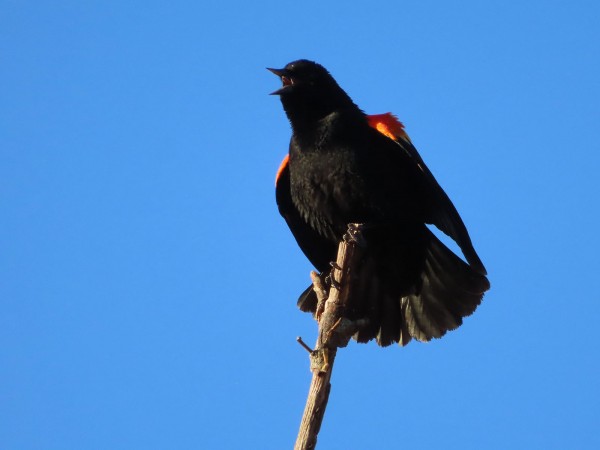About Red-winged Blackbirds
Red-winged blackbirds (Agelaius phoeniceus) are captivating migratory birds known for their striking appearance. Red-winged blackbirds are one of the most abundant songbirds in North America. Their scientific name, Agelaius phoeniceus, originates from the Greek words agelaios, meaning "flocking," and phoinikeos, referring to the color red. These birds sport glossy black plumage, with vibrant red patches on their wings, making them easily recognizable.
Red-winged blackbirds belong to the family Icteridae, which includes bobolinks, meadowlarks, orioles, cowbirds, grackles, and other blackbirds.
Female Red-winged Blackbird

Male Red-winged Blackbird
The Migration Study

Red-winged blackbirds breed across a vast range from the Yukon across Canada to Baja California, Costa Rica, Cuba, and the Bahamas. They migrate to southern and central states for winter. In spring, they migrate northward from their wintering grounds to breeding habitats across North America. During this time, they favor various wetland areas, including marshes, meadows, and lake edges.
The North American Breeding Bird Survey (BBS), a long-term, large-scale avian monitoring program, has documented declines in Red-winged blackbird numbers over recent decades. According to BBS data, Red-winged blackbird populations across North America have declined by approximately 30% from 1966 to 2015. Additionally, the Partners in Flight (PIF) initiative, which assesses bird population trends, lists the Red-winged backbird as a species of concern due to its declining numbers. PIF estimates a population decline of about 44% from 1970 to 2017.
Journey North launched the Red-winged blackbirds Migration Project in 1999. From 1999-2024 (Spring), this project focused on the timing of spring migration. In the Fall of 2024, Journey North now tracks both the spring and fall migration of this blackbird. This project relies on volunteers to provide essential data that helps researchers track and understand migration patterns. Volunteers are asked to record observations with precise details, including the date and time, location, and type of observation, whether stationary or while moving. Recording the duration of the observation also provides valuable context when estimating the number of species observed. Volunteers note life stages and specific behaviors such as foraging, flocking, and nesting. Capturing the observation with photos or videos enhances the data's reliability. Additionally, sharing detailed field notes on weather, habitat, and interactions enriches the observational report.
Understanding the timing and routes of Red-winged blackbird migration helps to identify critical stopover sites essential for the birds' survival during migration. Volunteer-submitted observational reports are crucial for guiding habitat protection and restoration initiatives. Additionally, studying Red-winged blackbird migration can provide insights into the effects of agricultural practices and urban development on bird populations. Since Red-winged Blackbirds often inhabit wetlands and agricultural areas, changes in these environments can significantly impact their populations. By monitoring their migration, researchers can assess the impact of land use changes and develop strategies to mitigate negative effects.
- Spring Migration
As temperatures warm, Red-winged blackbirds begin their journey north, preparing for the breeding season.
- Breeding and Nesting
Male Red-winged blackbirds take center stage during breeding, displaying their vibrant red shoulder patches to attract females. Females nest in dense vegetation, with nesting and egg-laying peaking in April and May. Their nests are typically built on the ground or near water in marshes, with females laying 3-5 eggs per clutch.
- Preferred Habitats
Red-winged blackbirds thrive in wetland habitats such as marshes and lakeshores, where they can find suitable nesting sites and abundant food.
- Fall Migration
As summer transitions to fall, Red-winged Blackbirds prepare for their southward migration back to warmer wintering grounds. This migration often takes them to southern parts of the United States and even into Central America.
Annual Cycle and Distribution
- January – February
Non-migratory red-winged blackbirds are in the western US and Central America.
- March
Peak male migration and territorial behavior, with females arriving later.
- April
Peak of male territorial behavior, nesting, and hatching of eggs.
- May
Nesting activity peaks, with many chicks hatching.
- June
Accordion content.
- July
Nesting concludes, and birds begin molting.
- August
Molting of body and flight feathers peaks.
- September
Birds gather in feeding flocks, preparing for migration.
- October
Migration and feeding in large flocks.
- November
Peak migration in southern states and Great Plains.
- December
Mostly on wintering grounds in central and southern states.

Identification

Adult male Red-winged Blackbirds exhibit glossy black plumage with bright red or orange shoulder patches, known as epaulets. These striking markings serve as visual cues during territorial displays and courtship rituals. In contrast, females and juveniles display more subdued brown and streaked plumage, helping them blend into their surroundings for camouflage.
- Male/Female
Males have glossy black plumage with vibrant red shoulder patches, while females are brown with streaked underpart
- Size and Shape
Stocky build, around 7 to 9 inches in length.
- Behavior
Territorial during breeding season, often perching prominently and vocalizing.
- Tail, Beak, Talons
Short tail, sturdy beak, and talons suitable for perching.
- Longevity
Varies but can live several years.
- Coloration
Glossy black with bright red shoulder patches in males, brown with streaked underparts in females.
- Wings
Red patches on wings in males, less prominent in females.
- Habitat
Wetland areas such as marshes, ponds, and lakeshores.
- Nesting Sites and Fledglings
Nests woven into dense vegetation, secretive behavior by females.
- Interspecies Interactions
Red-winged Blackbirds may interact with other bird species, particularly during migration and in mixed flocks.




